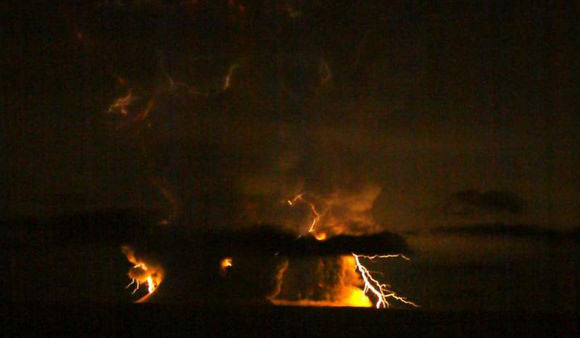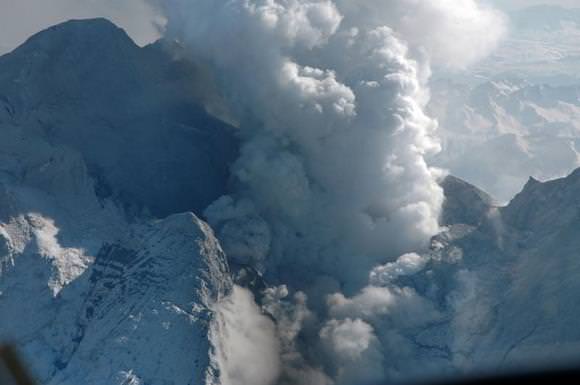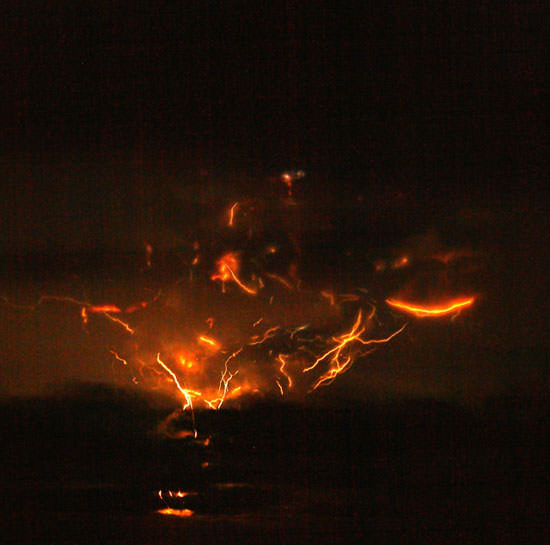[/caption]
When Redoubt Volcano in Alaska started rumbling in January, a team of researchers from New Mexico Tech hurried to south central Alaska to deploy a series of radio sensors. When the volcano began erupting overnight on March 22 and 23, the Lightning Mapping Array started returning clear and dramatic information about the electricity created within volcanic plumes and the resulting lightning. This is the first time ever anyone has been able to record data from a volcanic eruption right from the start. “We’re getting all the data we hoped to get and a lot more,” principal investigator Dr. Ron Thomas said. “Absolutely, the quality and quantity of the data will allow us to better understand the electrical charge structure inside a volcanic plume.”
Lightning is a frequent occurance during volcanic eruptions. The Lightning Mapping array allows scientists, meteorologists and storm chasers to pierce the veil of clouds to “see” lightning as it occurs.
“With each lightning flash, we’ll be able to monitor how it moves through the clouds and where it goes,” Thomas said. “If we take all our theories about lightning created in thunderstorms, we can learn about both types of lightning.”

Redoubt erupted explosively about 20 times in the first seven days of activity. Most volcanic eruptions have several distinct stages. In the case of Redoubt, a stage of explosive activity is followed by a second stage that includes dome-building and slow venting of ash, rock and gasses. Within the individual explosive eruptions, different phases of electrical activity are observed.
“First, we see an eruptive or explosive phase,” physics professor Paul Krehbiel said. “Electrical activity is continuous and strong. We see a lot of small electrical discharges as hot gasses come out of the volcano.”
The second phase involves the ash cloud as it drifts away from the volcano with the wind. This phase is punctuated by discrete lightning – or lightning bolts.
“After the explosion is over, there is a subsequent phase of plume lightning,” Krehbiel said. “Full-fledged lightning occurs in the cloud of ash and water both above and downwind of the volcano.”
During a week’s time, Redoubt has had several major eruptions that have produced prolific lightning, Krehbiel said.
“The lightning activity was as strong as or stronger than we have seen in large Midwestern thunderstorms,” Krehbiel said. “The radio frequency noise was so strong and continuous that people living in the area would not have been able to watch broadcast VHF television stations.”

The Redoubt eruptions are not over yet. After quieting down and appearing to go into a dome-building phase, just before sunrise Saturday, April 4, the volcano blew its top in the biggest eruption so far.
Thousands of individual segments of a single lightning stroke can be mapped with the Lightning Mapping Array and later analyzed on high-end computers to reveal how lightning initiates and spreads throughout a thunderstorm … or within a volcanic plume.
“We receive radio bursts of noise generated from sparks of lightning, just like the static you hear on your car radio during a thunderstorm,” Thomas said. “We will use our sensing stations to locate the lightning and track its path.”
Source: New Mexico Tech press release


I am really into Earth sciences- I hope this volcano stays at a VEI 4, however, volcanoes
are just like people, unpredictable. I’m sure the volcanologists keeps good data and try interprete what this beast is going to do. As intelligent these volcanlogists are about volcanoes, they can’t really predict if this volcano will have a real serious attitude and
kill anyone closeby,including the volcanlogists who ventures too close to these beasts.
If it goes to VEI 6 and much volcanic gasses and ash goes into the upper atmosphere, we can have another Mt Pinotubo type eruption that can have an effect on our atmosphere and weather.
Is there a more awesome word in existence than ‘Redoubt’? I don’t think so. Actually, ‘Redoubtable’ is.
Anyway, gotta love volcanology.
Nancy, great story and pix of a little studied and poorly understood element in the life of an eruptive volcano. Thanks for reporting on it and bringing it to our attention.
How have the emisions from volcanoes changed, and over what time? I heard that volcanoes now ain’t what volcanoes were as to what they spew and spewed forth. And how is that known?
From a different article:
“I (the author, not solrey) exchanged email with a group of scientists at New Mexico Tech about their research on volcanic lighting. They believe they’ve observed lightning between the eruption plume and the volcano right at the start of an eruption, suggesting that there are processes that occur inside the volcano to lead to charge separation. The process by which the charge is separated is unlikely to be the aerodynamic effects described above, since the plume has little time for such processes to occur and the strong turbulence in the plume would likely re-mix the particles before much charge separation could occur.”
“And that’s basically the story as it’s understood now. Nobody knows exactly what goes on when individual particles in the eruption plume interact, but somehow charge gets exchanged and the exchange is biased in some way so particles with different charge are segregated. This charge separation on a giant scale leads to lightning.”
The charge seperation, that seems to be ‘unexplained’, occurs between the ionosphere (which receives millions of amps from the sun) and the magma. Magma is ionized, therefore it’s a conductive plasma. Water vapor is also ionized, therefore it also is a conductive plasma. Dry air and Earth’s crust are relatively weak insulators. When the voltage potential gets strong enough and/or pressure forces the magma closer to the surface, the insulators break down and a massive discharge occurs between the two ‘plates’ of the circuit, the ionosphere and the magma. The volcanic gas and ash are also ionized, or in a plasma state. There should also be ionospheric ‘sprites’ or ‘blue jets’ above powerful volcanic eruptions. Electric discharge could be a ‘trigger’ for some, or most, eruptions. The power, and triggers, of a volcanic eruption might be a combination of geologic forces and electric discharge. 😉
“We see a lot of small electrical discharges as hot gasses come out of the volcano.”
solrey, the ‘agreed’ upon theory concerning the generation of electrical activity thru traditional interpretations may need to be re-examined?
I am curious if there is a current gravitational anomoly map for Mt. Redoubt?
How do volcano’s, thru magma conduits (conductive), connect Earth’s core and mantle to Mr’ Sol’s prodigious electrodynamic output? What impact?
Does that connection create a ‘hole’ in Earth’s geomagnetic field? similar to the South Atlantic anomoly?
Pass an electric field thru marcury, and the viscous nature of the liquid state changes, becomes ‘stiffer’.
Does a similar state change occur when an E/M field is generated in superconducting compressed magma?
Should that E/M field be rotating, then what sort of mixing might occur? Magma tornado’s anyone?
@aqua
Thanks for mentioning a possible gravity anomaly connection. The high gravity anomalies correspond quite nicely with active volcanic regions. including Yellowstone, Hawaii and the Mid-Atlantic Ridge.
http://www.csr.utexas.edu/grace/gallery/gravity/03_07_GRACE.html
The current is basically distributed, unevenly, through the magnetosphere into the ionosphere where it continuously discharges to ground in a number of ways, lightning being the most obvious. We know that discharges to the ionosphere happen above thunderstorms (sprites, elves, blue jets), that extensive electric environment around thunderstorms is much higher than charge seperation due to friction can account for. In the article, the researchers compared Redoubt’s lightning to that of a thunderstorm. It seems reasonable to conclude that ionospheric discharge should occur with volcanic lightning. I don’t know if anyone’s studied this yet or not.
Volcanic plumes have been discovered to rotate counter-clockwise and develop five lobes at the margins…geometrically a hexagonal pattern. Their rotational velocity seems to be a bit slow for a purely mechanical cause of a hexagonal vortex. A hexagonal vortex is a common shape of a diocotron instability in an electric discharge, though. 😉
Solrey and aqua both deserve the Nobel Prize for their award winning theory of the relationship between electricity and volcanism. After all these years, who knew, it was so simple?
@jonhanford
Simple? Hardly. Complex geologic and electromagnetic forces work in conjunction in a series of positive feedbacks that lead to an eruption.
Including a voltage potential to the ionosphere, and modeling the behavior of the magma and atmospheric moisture (both ionized) as a conducting plasma, might be the mechanism for charge seperation, i.e. voltage potential, that they can’t explain. And yes, after all these years, there is a whole lot we still don’t understand about volcanology, among many other things. Why do you think they surrounded Redoubt with lightning detectors? They’re still trying to figure it out, and guess what? They discovered a few ‘surprises’.
Electric discharge commonly happens in a series of ‘strokes’, which can last anywhere from microseconds to hours, days, weeks or longer, for large scale events. Similar to how most eruptions occur.
The world is forever in your debt for fully explaining the few ‘surprises’ you now claim that professional volcanology has discovered, verified, analyzed and drawn conclusions from. Who needs further info on this topic anymore? Just ask solrey!
According to someone elses correspondence, which I quoted in a previous post, the scientists studying the lightning at Redoubt don’t know what causes PRE-ERUPTION charge seperation. They’re stuck on mechanical, friciton based ‘charge seperation’ (ionization). Maybe thinking outside that mechanical ‘box’ would assist in better understanding of the processes.
At least I’m positing a unique solution. I have yet to see evidence to the contrary, beyond sarcasm from you, jon h. Do you have any ideas about what causes such powerful, pre-eruption charge seperation?
Actually, I’d love more info on this topic, specifically more detailed data about the overall electrical environment around a volcano. Other sensors, besides the simple lightning monitors, would be required, and I think that’s the approach the scientists themselves are taking.
Physics of electric arcing:
http://www.osti.gov/bridge/servlets/purl/861163-A0F82g/861163.pdf
Diocotron instabilities:
http://nonneutral.pppl.gov/pdfpapers/PP.1998.5.3497.RD.pdf
solrey says: “At least I’m positing a unique solution.” There’s as many unique solutions as there are users of the internet. Get real. Let’s see some peer-reviewed paper published recently that backs up your claims about the symbiosis of electromagnetism and vulcanism . Not “Diocotron instabilities” or “the Physics of electric arcing” but EM and volcanology. This volcano & current eruption are caused by plate subduction below Redoubt Volcano. Newly melted Arctic Ocean crust is being heated as its being subducted, supplying Mt Redoubt with fresh magma.
After carefully scrutinizing the 2 papers you gave links to, I saw no mention in either one about magma, volcanoes, lava or geology. The only link between these two papers and actual geophysics is in your head. Show me the research, not some useless collection of off topic research that you use to support your dubious claims. Maybe Feenix is right, Wiki needs your picture on its’ page on ‘solipsism’.
Show me a picture of this pool of superheated rock you claim is caused by friction, Jon. You hoist yourself on your own petard, you know. You have a pet theory just as everyone else does, with no more observable fact. You have observations and theories.
There is a hexagonal storm permanently in place at the north pole of Saturn. hexagonal ‘impact’ craters on moons and planets throughout the solar system. Hexagonal ash clouds over our own volcanic eruptions. Yet you posit that plasma physics has no relation to geology or vulcanology.
Yet you’ve seen the lightning. Do you know what lightning IS, Jon??
It begins with a ‘P’….